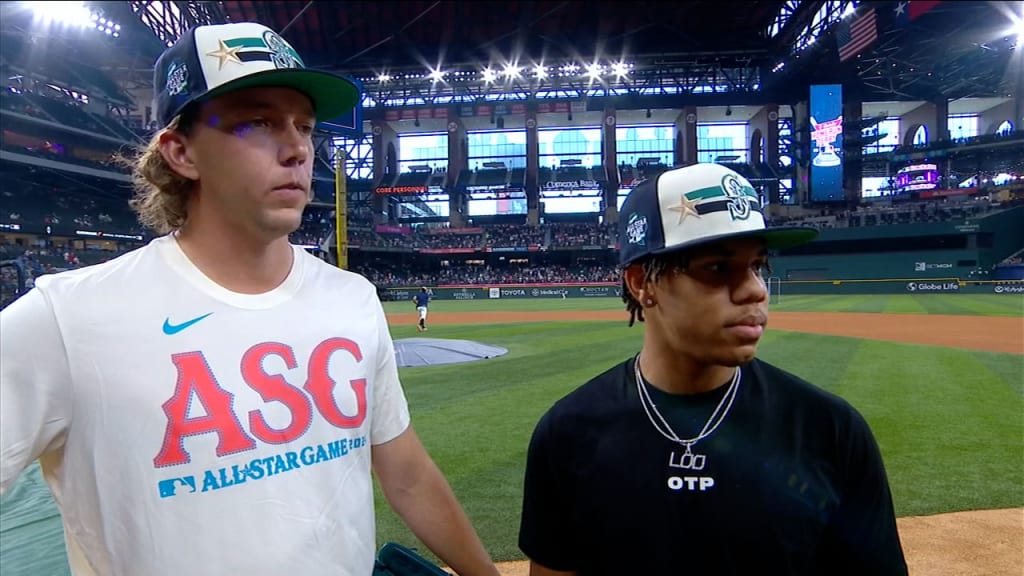Mariners molding once-in-a-lifetime player
This browser does not support the video element.
This story was excerpted from Daniel Kramer's Mariners Beat newsletter. Josh Kirshenbaum pinch-hit on this edition. To read the full newsletter, click here. And subscribe to get it regularly in your inbox.
SEATTLE -- It’s going to be at least a few years until anybody donning catchers gear in the Mariners dugout is going to have to catch Jurrangelo Cijntje (No. 7 prospect). But the thought experiment is already an intriguing one: How do you game plan with a pitcher who can switch sides mid-inning?
“I've never even thought about it before,” Cal Raleigh said. “It's very unique, different.”
Mitch Garver had a similar response: “I really don't know. It really depends on how they use him, like as a starter, long reliever, who knows? It could be interesting either way.”
So before looking forward to how the pitching coaches in the Mariners' organization will be able to make use of their new ambidextrous hurler -- who they selected No. 15 overall in the 2024 Draft -- take a step back to the last team Cijntje suited up for.
What’s it like to begin working with a switch-pitcher? Just ask Mississippi State pitching coach Justin Parker, who took the job in Starkville last summer and immediately began working with Cijntje, who was coming off a tough freshman season.
“I’m watching him in the fall and I’m thinking to myself -- all of the things that go into this, where you just talk about it and it’s kind of a cool story with switch-pitching -- no, I’m watching him warm up twice,” Parker said. “I’m watching him do his routines twice, I’m watching him do two different bullpens, I’m watching him train with our athletic trainer twice. It’s double everything.”
This browser does not support the video element.
That extra work was something Cijntje said partially came from advice from Pat Venditte, the only full-time ambidextrous pitcher in Major League history. With an extra arm to care for, everything’s going to take more time.
But it was up to Parker and the staff at MSU to figure out the best way to use their one-of-a-kind weapon. Cijntje’s uniqueness turned heads in 2023 when he was a freshman. But it didn’t stop opponents from tagging him for an 8.10 ERA.
The first thing Parker did was move him back in the Bulldogs’ rotation. By making him throw either the second or third game in SEC series, the MSU coaching staff -- and Cijntje -- got a live look at opposing lineups to formulate game plans.
Then, the Bulldogs changed things up by utilizing Cijntje’s ambidextrousness less.
Extending common knowledge to an uncommon pitcher, it would make sense to have Cijntje pitch righty to right-handed batters and lefty to left-handed batters. But the Bulldogs found that he struggled to stay in a rhythm going back and forth so much. Instead, they had Cijntje go for longer stretches right-handed, giving up a few side matchups for more consistency.
“That was part of, strategically, what we wanted to do early, and just finding two lefties in the lineup that were maybe susceptible left-on-left and were good matchups for him,” Parker said. “And then I gave him the freedom in the game to say, ‘If I’m feeling it, I’m going to stay right or I’m feeling it here, I’m going to go more left.’ That was part of his maturation, [a] part of his growth just to give him a little more ownership of it.”
This browser does not support the video element.
When Venditte first started in the Yankees' organization in 2008, he threw nearly entirely right-handed, including against lefties. But by the time he earned his first callup with Oakland in 2015, he had gone more matchup-heavy. From ‘15 on, Venditte faced 1,132 batters with the side advantage, compared to 236 against it.
Parker said that he considers Cijntje as dangerous going right-on-left as he is left-on-left. Right-handed, Cijntje has better velocity, a deeper arsenal and slightly better command. But as a southpaw, he gets sink to get more grounders.
After coming to Seattle to officially sign with the Mariners, Cijntje set off for Arizona, where a team of analysts, coaches and coordinators were waiting to get their crack at molding a once-in-a-generation weapon.
“They're going to have to find a way to use his best pitches and find out [how] they match up against different hitters,” Garver said. “That's something we do really well here. We use our best pitches all the time. 'How do they match that up with multiple lineups, multiple switch-hitters?' All of that stuff comes into play, so it'll be interesting to see how they do that.”

